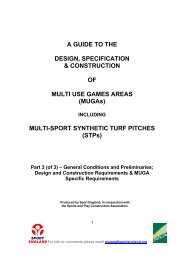View - North East Lincolnshire Council
View - North East Lincolnshire Council
View - North East Lincolnshire Council
You also want an ePaper? Increase the reach of your titles
YUMPU automatically turns print PDFs into web optimized ePapers that Google loves.
BOC Immingham Dissolved Acetylene Project Environmental Statement: Vol. 2 Main Text<br />
3.32 Carbide will be delivered to the site in turnbins iii , which will be stored in the Full Carbide Turnbin<br />
Store iv , ready for transfer to the Generator Building as required. Within the Generator Building<br />
turnbins will be lifted using a crane and positioned above the acetylene generator. A shaker plate<br />
will then feed the carbide into the generator at a controlled rate. The ratio of water to carbide is<br />
approximately 8:1 (by weight). The carbide then reacts with the water in the generator to produce<br />
acetylene gas at a reaction temperature of approximately 80°C. The reaction also produces lime<br />
slurry at the bottom of the generator.<br />
3.33 The plant has been designed to produce 300 kg/hr of acetylene, which results in approximately<br />
6,270 kg/hr of lime slurry. Under typical operating hours this equates to 1,200 t/y of acetylene and<br />
approximately 25,000 t/yr of lime slurry.<br />
3.34 The raw acetylene gas will contains trace quantities of ammonia, phosphine and hydrogen<br />
sulphide as a result of impurities in the raw material. When the gas exits the generator it passes<br />
through a water scrubber which removes any ammonia and cools the gas. The gas then passes to<br />
a Gas Holder, which maintains the system pressure at approximately ~30 mbarg, and on to<br />
chemical scrubbing towers (two sulphuric acid scrubbers and one sodium hydroxide scrubber) to<br />
remove the other impurities. The acid and alkali scrubber systems sit in a bund with a dividing<br />
wall. The two sections of the bund will each have a sump that would allow the collection of any<br />
spilled effluent. The effluent from the scrubber systems and sumps is collected in Waste Liquor<br />
Storage Tanks. There are two dedicated Waste Liquor Tanks, one for effluent from the acid<br />
scrubber system and one for the alkali scrubber system.<br />
3.35 The clean acetylene gas passes from the scrubbers to the compressors which will raise the gas<br />
pressure to approximately 25 barg. The compression process also helps to remove water from the<br />
gas. Each of the four gas compressors (and the air compressor in the Plant Room) is connected<br />
to a clean water trap and an Oily Water Separator (OWS). Clean water will either be recycled into<br />
the process or will be discharged into the surface water drainage system. The oily water sludge<br />
will be periodically removed and disposed of offsite.<br />
3.36 The gas is dried and fed via a header system to cylinder filling points. The drying process uses a<br />
‘High Pressure’ dryer, which is designed to operate continuously to remove moisture from the<br />
acetylene by adsorption. The dryer consists of a two piece drying tower that contains adsorbent<br />
type silica gel. One tower adsorbs moisture while the other is regenerated, after about four hours<br />
the towers are changed and the inverse relationship occurs. Acetylene gas is used for<br />
regeneration. After use, the acetylene is fed back into process. The water from the drying process<br />
is pure water and is directed to drain via an external tundish. The clean water will either be<br />
recycled into the process or will be discharged into the surface water drainage system.<br />
3.37 From the cylinder filling points gas is charged into cylinders or bundles i . The cylinders contain<br />
acetone, which is a solvent. The acetylene gas dissolves in the acetone. The cylinders also<br />
contain a porous mass which helps to stabilise the acetone acetylene solution. Heat is generated<br />
when acetylene is compressed into the cylinders and bundles. A chilled, closed loop, water spray<br />
is used during cylinder and bundle filling operations to increase the rate of absorption of gas. The<br />
Cylinder Cooling System requires the use of propylene glycol (hereafter referred to as ‘glycol’ to<br />
maintain a temperature at approximately -8°C. The Bundle Cooling System used chilled water<br />
only. Cooling Systems are described in more detail below see paragraph 3.46 onwards).<br />
iii<br />
The turnbins are metal containers and each one will contain 1.8 t of carbide.<br />
iv<br />
The site layout and locations of buildings and storage areas etc. are provided in Figure 3.2 and Figure 3.3 and described in a<br />
subsequent section of this Chapter.<br />
5100935.404 Environmental Statement August 2011 21




